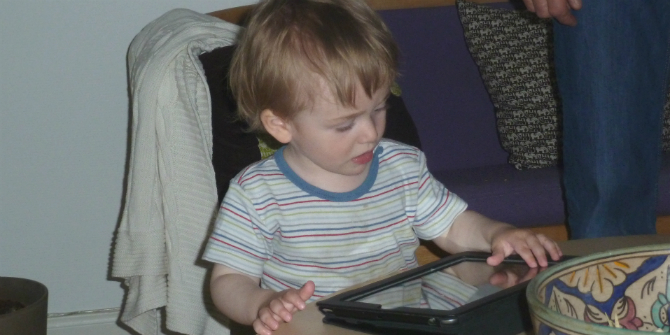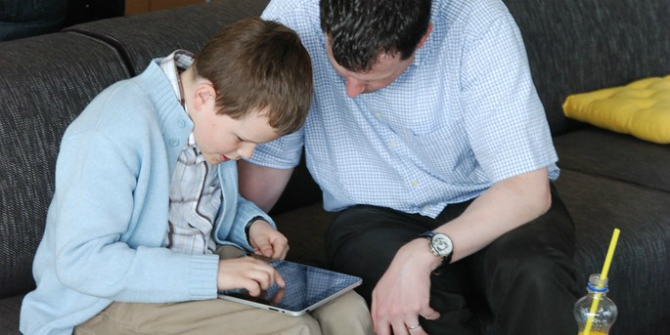 Sonia Livingstone was recently asked to write the foreword for Children and Families in the Digital Age: Learning Together in a Media Saturated Culture edited by Elisabeth Gee, Lori M. Takeuchi, and Ellen Wartella. Here’s what she had to say. Sonia Livingstone is Professor of Social Psychology in the Department of Media and Communications at the London School of Economics and Political Science. She leads the project Preparing for a Digital Future, which follows the recently completed project The Class, both part of the MacArthur Foundation-funded Connected Learning Research Network. [Header image credit: E. Yourdon, CC BY-NC-SA 2.0_2]
Sonia Livingstone was recently asked to write the foreword for Children and Families in the Digital Age: Learning Together in a Media Saturated Culture edited by Elisabeth Gee, Lori M. Takeuchi, and Ellen Wartella. Here’s what she had to say. Sonia Livingstone is Professor of Social Psychology in the Department of Media and Communications at the London School of Economics and Political Science. She leads the project Preparing for a Digital Future, which follows the recently completed project The Class, both part of the MacArthur Foundation-funded Connected Learning Research Network. [Header image credit: E. Yourdon, CC BY-NC-SA 2.0_2]
Where shall we start, and where shall we focus our gaze, when making sense of the influx of digital devices that fill our homes and workplace, absorbing the attention of both children and parents, promising so much yet often proving frustrating, disappointing, worrying. It is tempting to start with the technologies themselves, for they highlight clear differences between how things used to be, including in our own childhoods, and how they are now. But as social scientists and historians know well, recent decades have seen many changes, among which digital media are among the most salient but are not, in any simple terms, the most influential.
The contributors to this book carefully demonstrate through painstaking empirical work that to understand modern families we must start by situating them at the intersection of the global movements of people and cultures, growing insecurity and risk in financial and employment futures, internal contestation over gender, authority, and social norms and, yes, also, transformed means of communication, information, entertainment and relationships within and beyond the home. Then, rather than focusing our analytic gaze on either the technology or the child, we should examine their mutual dynamics, along with the emerging interactions among parents, teachers, siblings, and friends with and around digital media. For all of these are changing in complex ways. But do they bring new opportunities to learn? And do the less well-off, including the growing segment of Hispanic-Latino families in the US, benefit in practice?
These are important questions, given the huge investment — national, community, and individual — in all kinds of digital devices, networks, and contents and, even more expensive, the training, expertise, and reshaping of societal infrastructures to accommodate and harness them supposedly for public good. While other books explore the associated transformations in the public, private, and third sectors, this one undertakes perhaps the most difficult task: working in depth with over 200 families to understand how they are finding ways to engage with the media in their domestic lives.
Building on prior insights that stress the value and potential of social and digital connections (youth-led, interest-driven, peer-supported), the authors variously demonstrate ways in which digital media afford new sites for learning individually and together, at home and, especially, between home and school. They thereby qualify and contest the multiplicity of myths that abound in academic, policy, and public discourses about digital media — that children know it all already (as so-called “digital natives”), that parents know nothing about it (as so-called “digital immigrants”), that time with media is time wasted, that families are being broken apart by the multiplicity of personal screens, that the risks of digital media vastly outweigh the opportunities, and more.
But this does not mean all is plain sailing in the lives of modern families in the digital age. The fieldwork presented here, among many other findings, tells tales of school-provided laptops increasing the home-school disconnect for some low-income parents, of teachers underestimating how parents may use digital technologies to both support and complement learning in school, and of parents hampered by the belief that media may support entertainment or learning but not both. Yet in the best instances, problems such as these have become familiar to the expert community of scholar, policy makers, and practitioners that shape families’ future prospects. And while this does not, in and of itself, mean that the problems are being swept away, it does provide the basis for learning within that community. For while we rightly love to share best practice in digital media learning, it is often from past mistakes that we can learn the most.
Here we find some of the most creative suggestions emerging from the experiences of today’s families. To recognise how children develop expertise in searching, evaluating, and communicating knowledge as they act as online information brokers for their families. To relish the playful engagement of a father mixing media sources to support his little son’s fascination with space exploration. To notice that it is around co-viewing of the supposedly trashy telenovela that mother and teenage daughter get to have those sensitive conversations that it’s otherwise hard to begin.
My hope is that this book can help bring such instances to wider public attention, countering talk of harmful media, passive kids, and clueless parents. Also important, of course, would be a digital media industry that worked with parents, teachers, and kids to scaffold such positive experiences for greater benefit. Families need a media that represents the diversity of their audiences, that encourages imaginative play and shared learning among family members and that minimises oppressive, stereotyped and over-commercialised contents. So let’s hope the industry reads this book too.
Notes
This post was originally published on The Joan Ganz Cooney Center site and has been reposted with permission.
This post gives the views of the authors and does not represent the position of the LSE Parenting for a Digital Future blog, nor of the London School of Economics and Political Science.






